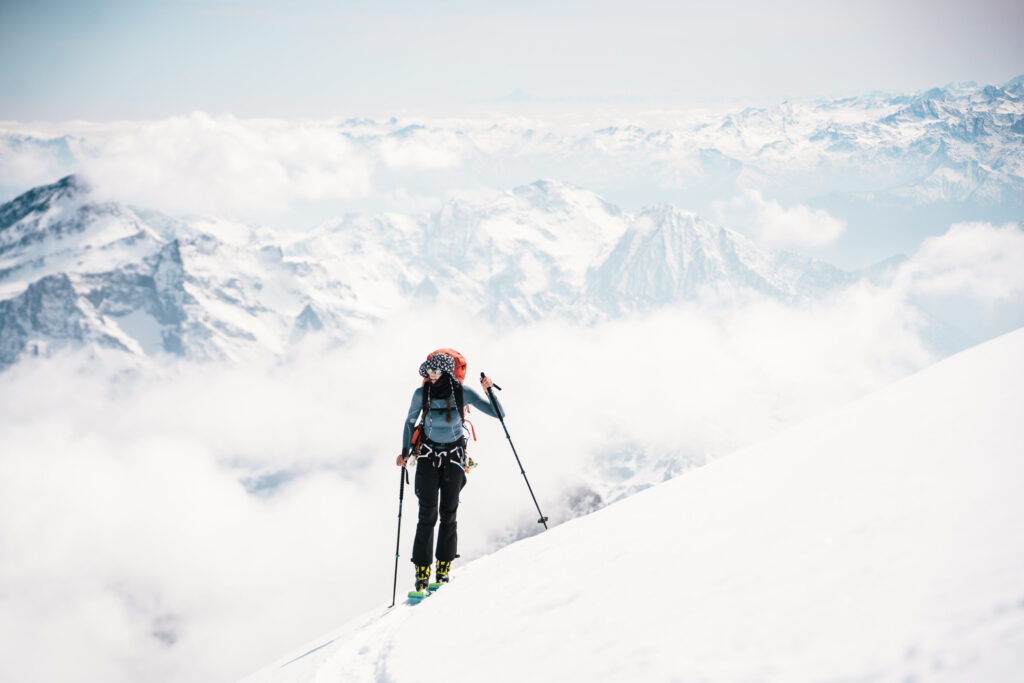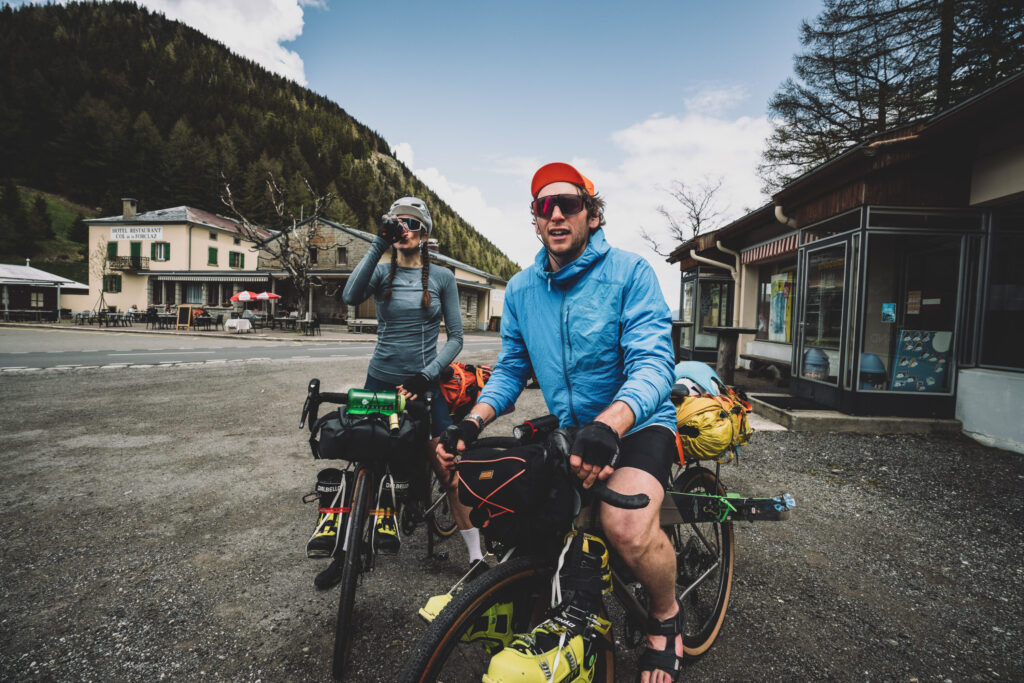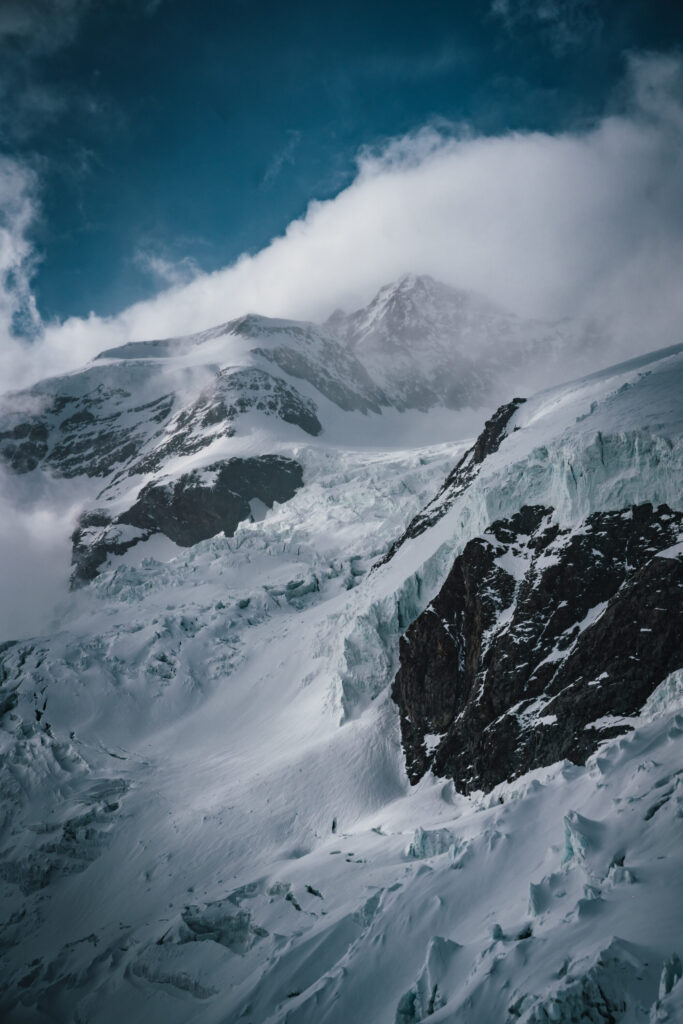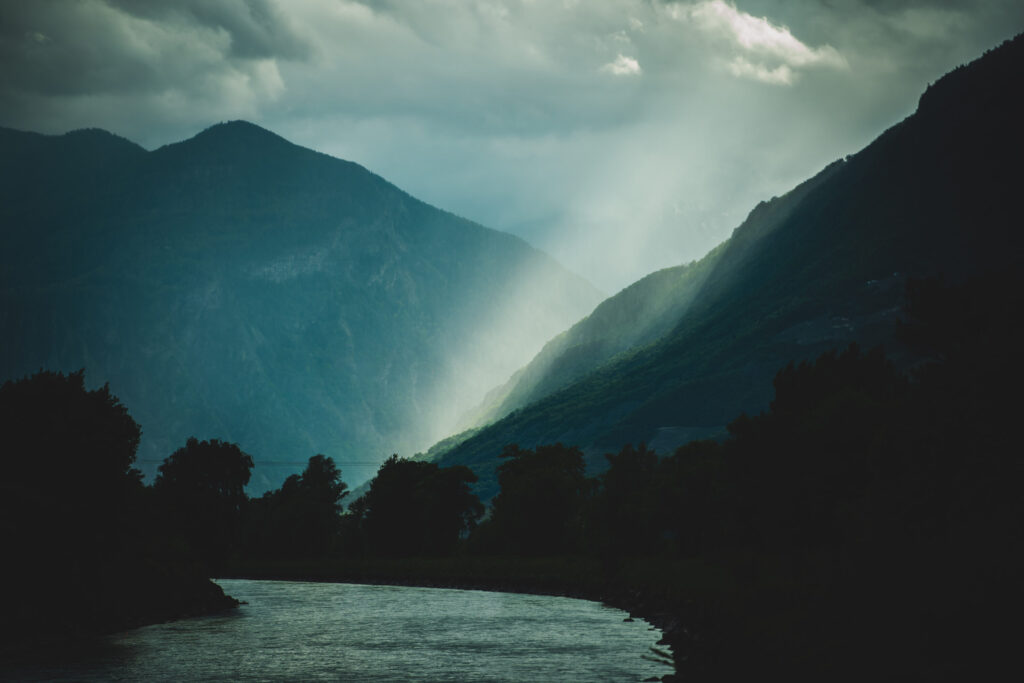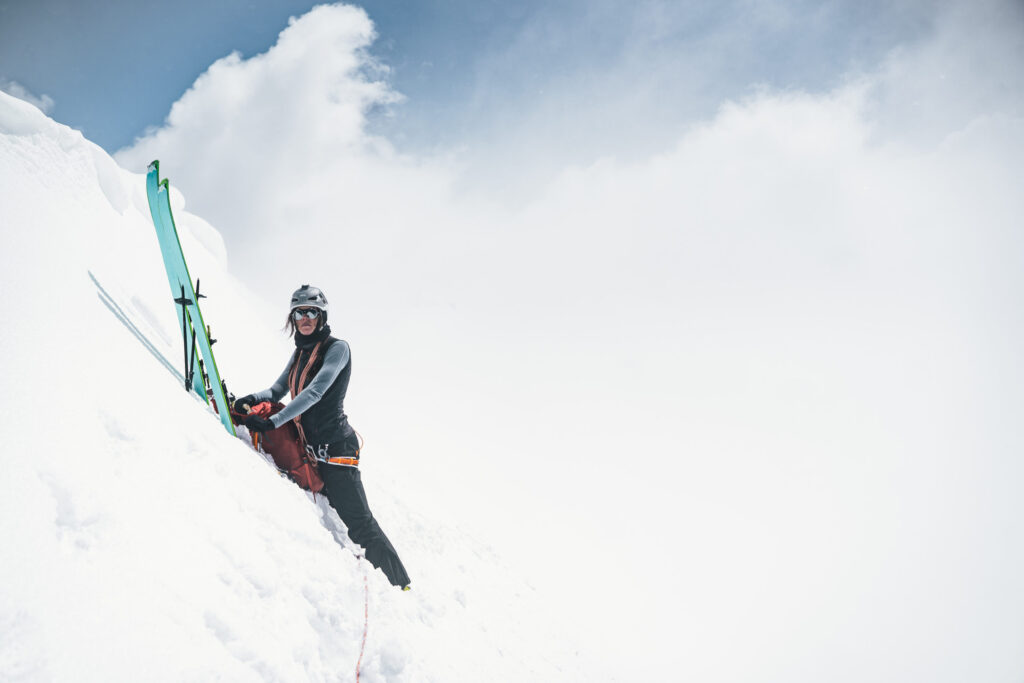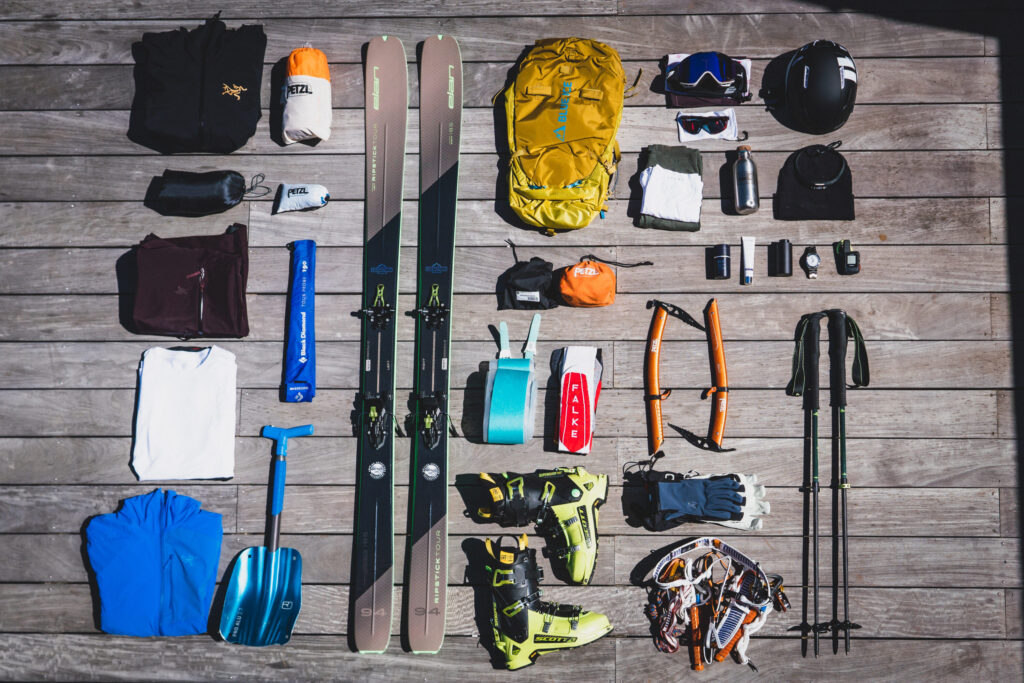Alpine X
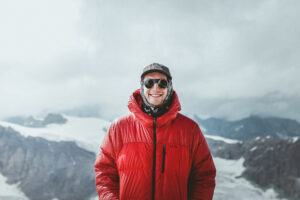
During what was a year of strange weather patterns and unreliable snow conditions, after his first full winter in Chamonix, Aaron Rolph was not content with his season’s yield. The steep north faces were rarely, if at all in condition, and all too often with warmer air, many of the more committing lines were too unsafe to ride. A little bored of the Vallée Blanche at this point he decided that when the spring touring season arrived, he would go after it.
Alpine X was born. With his good friend Jess Clark he’d attempt to climb and ski the ten highest peaks in the Alps, in one continuous human-powered journey. This one big ski-mountaineering adventure would make up for a winter that never quite delivered, right? Well, not exactly.
This story first appeared in issue 08 of BASE magazine.
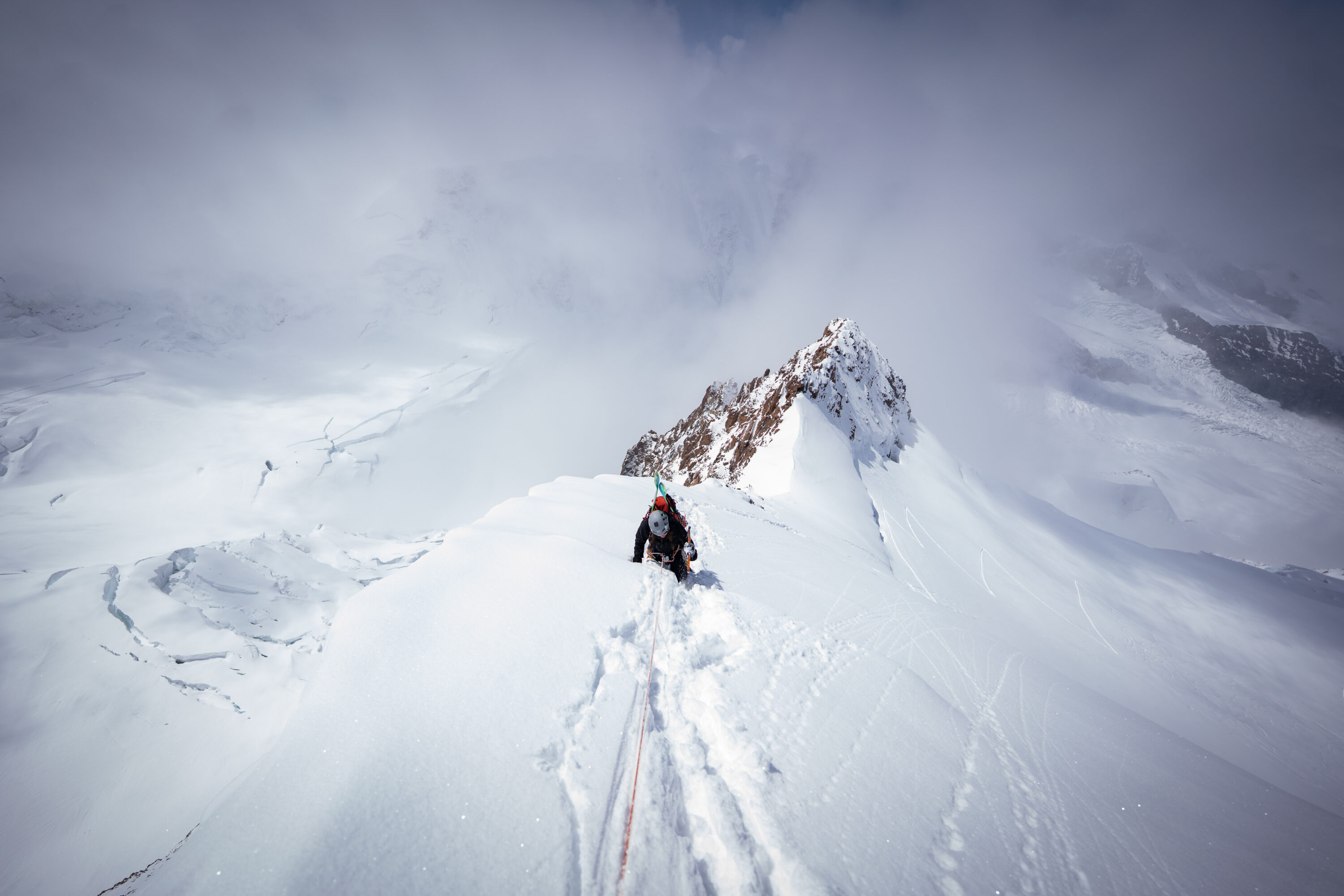
Jess Clark bootpacking through deep snow on the Monte Rosa ridge. © Aaron Rolph
Trips to far-flung and exotic places are at times a wonderful perk of being a ‘professional adventurer’, whatever that means, but such trips aren’t without a palpable feeling of climate guilt. Yes, I offset my emissions but that doesn’t stop my actions from being a part of the problem. Anyway, that’s a debate for another time. Lucky enough to live in the French Alps, we wanted to make this trip genuinely climate-conscious, powered by flapjack rather than hydrocarbons. Human-powered and self-supported, we’d pedal ourselves, our skis, boots and kit between the peaks.
Almost all of our objectives stood over 4500m, meaning we’d desperately need to get some acclimatisation before going too high, and thankfully the iconic Swiss town of Zermatt isn’t short of options. We set our sights on nearby Breithorn (4164m) which provided a simple enough start to our campaign.
It feels good to have ticked off a new 4000er, albeit not on our Top 10 list. We ski down into Italy and traverse the heavily-crevassed glaciers to the Ayas Guide refuge. As the only guests, we find ourselves welcomed with especially open arms, treated to lavish Italian food and a shot of limoncello or three with the staff.
After chatting with the guardian, it becomes apparent our next peak that stands in the way, Castor (4000m) is in pretty poor condition, having been scoured of snow by relentless high winds. Castor, which is usually known to be an approachable summit, is littered with large patches of ice on the higher slopes, but avoiding this mountain would mean a diversion of at least a couple of extra days.
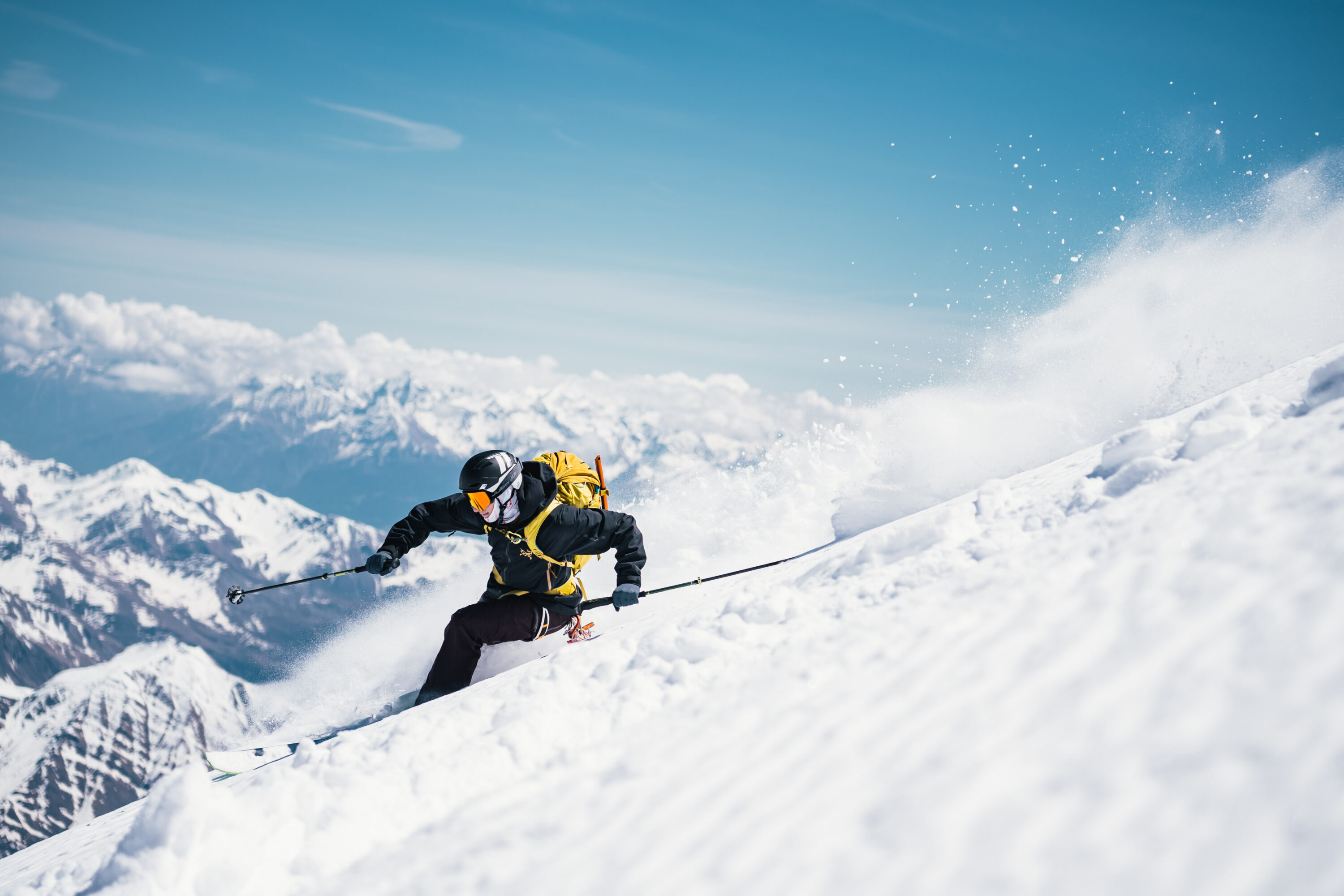
Aaron shreds fresh powder off the summit of Mt Blanc © Aaron Rolph
It was clear that nothing about this trip was going to come easy
We set alarms for 4am and head up to see for ourselves. Jess and I both feel strong for the early morning skin up the glacier, and the mountain vista only gets more impressive as cool blue hues are gradually displaced by vivid pinks and oranges.
As we reach the upper slopes, it’s clear the normal route that traverses to the right won’t be passable, the ice is thick and too brittle to sink our lightweight axes into. We find ourselves in a maze of deep crevasses attempting to navigate around the ice, until we decide the only workable route is to traverse into the rock band where the snow is softer and deeper. Jess builds an anchor with her ski for me to cross a wide open crevasse which appears to run deep into the glacier, and thankfully the bridge holds until I reach solid ground.
The mixed climbing up the shoulder is manageable, and from there we walk a knife-like ice arête which feels like walking the icey plank and onto the final ice ramp which we climb, carefully protecting it with a series of three ice screws. While we were pleased to be up and over this all-important peak, it was clear that nothing about this trip was going to come easy.
We follow the beautifully exposed ridge, revealing a view of Lyskamm West. Although ambitious, we’d loosely hoped to traverse onto the eastern summit. The peak was in a pretty laughable state, covered entirely in blue ice from this aspect. Turning to Plan B, we’re forced to descend and skirt numerous cliff bands making for a long day at altitude. As we climb the only peak that lies between us and a warm bed, Naso del Lyskamm (4272m), Jess is starting to struggle, complaining of blurry vision, and I can see definite signs of overexertion.
Issues with endurance are rarely left unsolved after eating, so forcing some chocolate bars down her, we make it slowly over the summit, cramponing one step at a time. The weather quickly closes in around us and the mood in the fresh mountain air becomes increasingly unsavoury. Descending on some of the worst snow I’ve ever had the displeasure of skiing, we carefully navigate the unbreakable-breakable crust in an intermittent white-out until I find myself confused as I find myself coming to an abrupt stop. I look down at my leg, my ski still attached, dangling over a vast, airy chasm. I’d broken through a weak bridge and found myself halfway into a deep crevasse. Precariously holding on with no room to spare, I’m fortunately able to use my upper body to drag myself away from the 10m drop and back to safety.
Having now been on the move for over 15 hours, we finally reach the Gnifetti refuge, relieved to see the back of the day.
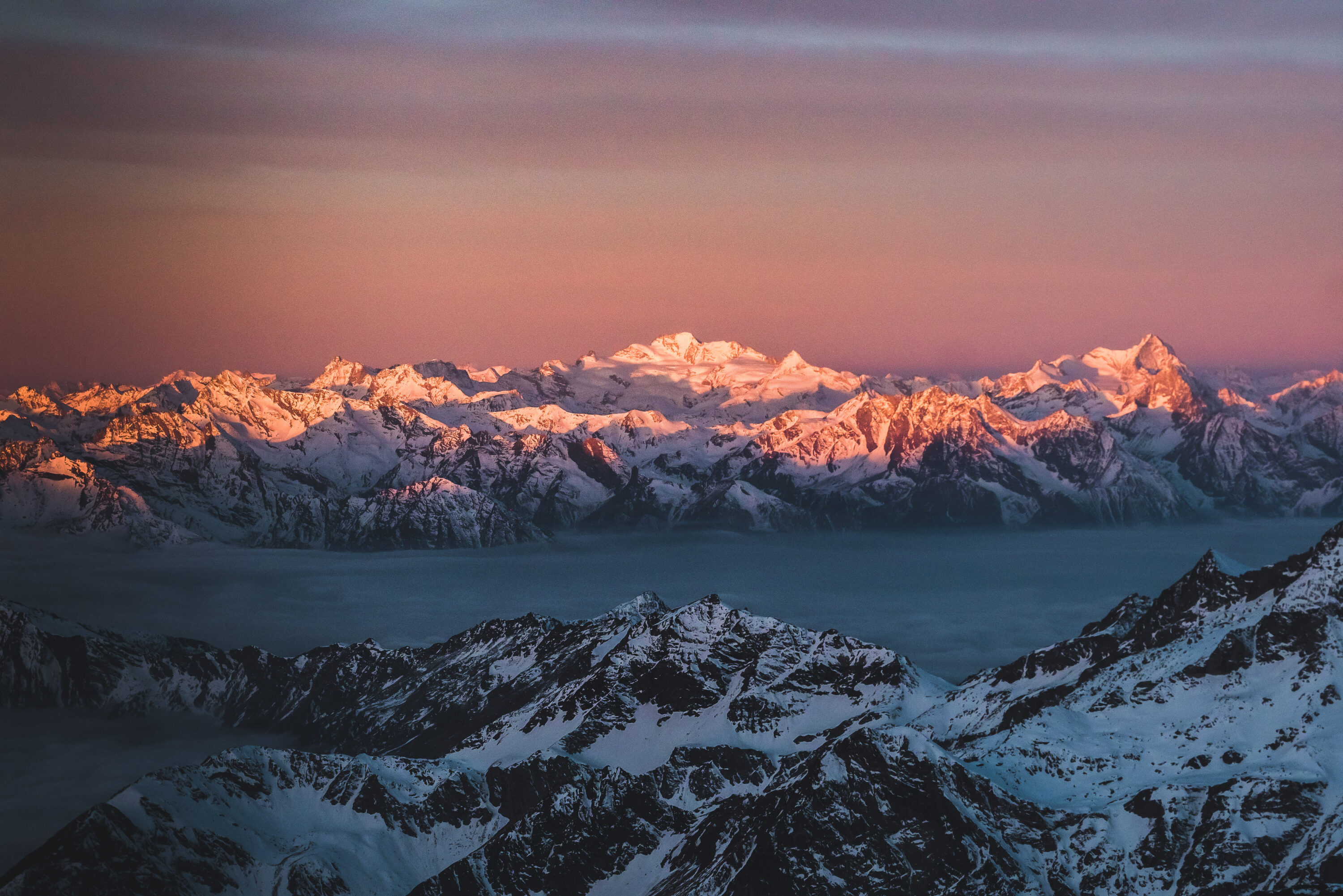
First light hitting Corno Bussola © Aaron Rolph
With some bad weather passing through, we’re treated to an enforced rest day allowing us to relax, acclimatise, eat and plan our next attempt on the Lyskamm ridge. Getting the beta from the guardian didn’t prove particularly fruitful as it becomes clear no one has tried to climb the peak yet this year.
Heading out early the next day, we navigate the same complex glacier terrain, moving with other groups who are heading towards neighbouring peaks Vincent Pyramid and Parrotspitze. Even this relatively straightforward terrain wasn’t without difficulty, we witness an Italian group losing a member of their team into a crevasse. Thankfully they pull him out without injury.
Parting ways with the other groups, we’re now trail breaking towards this beautiful and intimidating peak. We find the usual marked route impassable with a colossal bergschrund [a deep and broad crevasse] meaning that despite our best efforts, we are unable to make the snow bridge safe to cross. We do however find an alternative way up, boot-packing up the steep face to meticulously traverse the snowy ridge for around a kilometre before reaching Cima di Scoperta (4335m).
Now close to the final summit face, the ridge steepens to a point where the gradient no longer holds the soft snow and it’s clear we have no choice other than to try the arête. After fighting through the snowy cornice, I get eyes on the impossibly exposed north face and can properly assess the conditions. Much to our frustration, one side of the ridge is covered in deep, soft wind slab, and the right has a firm wind crust on top of similarly soft powder snow. We have absolutely no way of knowing where the actual ridge itself is. We’re a short distance to the final summit face which looks passable, but we’re forced to make our first of many difficult decisions of the trip. A fall down either side of the arête would almost certainly result in the worst possible outcome, and without knowing where solid ground is we just can’t take that risk.
We turn, clip on our skis, put some careful turns down the steep and warm south face before dropping the bergshrund and skiing back to the Gnifetti refuge. Back to safety, it’s hard to not let the decision go round in your head, wondering whether we could have got through and therefore opened Lyskamm Oriental (4527m) but as always, the mountain will be there for another day.
The following day, we set about touring back up the same glacier, instead now heading east via Balmenhorn (4167m) and Ludwigshöhe (4344m). After a short descent in soft fresh snow, we reach the foot of our two main objectives. We first make our assault on Zumsteinspitze (4573m) which has no tracks and an exposed ridge. We combat a short section of ice, crossing the bergschrund and onto the ridge. There is another soft snow cornice but the pack feels stable and before too long we’re able to get onto the arête itself. With some mixed climbing we move upwards, and take our final steps onto the summit. The feeling is one of joy and relief that our project is underway and being surrounded by 4000ers in every direction makes for pretty incredible views. From here the true enormity of the Lyskamm north face becomes very apparent, and the Duffourspitze summit almost as impressive. Once back touring across the plateau, we set our sights onto Signakuppe (4554m) where we switch to crampons on yet more firm snow. Although the ascent proves relatively straightforward, a long day spent at altitude catches up with both Jess and I, and we’re forced to follow a pretty sedate pace near the top.
We’re smiling despite our pounding heads, excited to clip into our skis and enjoy the big descent down to the hut. Having successfully bagged the two big peaks, we’re now skiing perfect light powder, weaving through enormous crevasses and taking in some of the most impressive scenery the Alps has to offer. After almost 2000m of wonderful glacier skiing, we reach the impossibly modern Swiss refuge and enjoy a beer.
Accessible from Zermatt, this area is renowned for hosting some of the best ski touring in the world, not least the second highest peak in the Alps – Monte Rosa. To our amazement, this 120-bed refuge is almost entirely empty as we take advantage of a dreary grey snow day and take a day’s rest and prepare for our assault on Monte Rosa the following morning.
Weather forecasts are mixed and conflicting, and although there’s no obvious window, if we are to continue to get anywhere on this project we can’t get away with waiting only for the bomber windows. Setting off just before first light, it’s eerily calm and feels akin to a clagged-in day in the Scottish Highlands, or maybe the Moon. Thick clouds roll in and out all morning, leaving us at times with only a few metres of visibility. With a fresh dump and seemingly no one else anywhere near this mountain, cutting the skin track through a couple of feet of fresh snow is hard going, but nevertheless, we make good progress. As we near the summits, the clouds lift enough to reveal the daunting face of Nordend and the summit ridge of Duffourspitze.
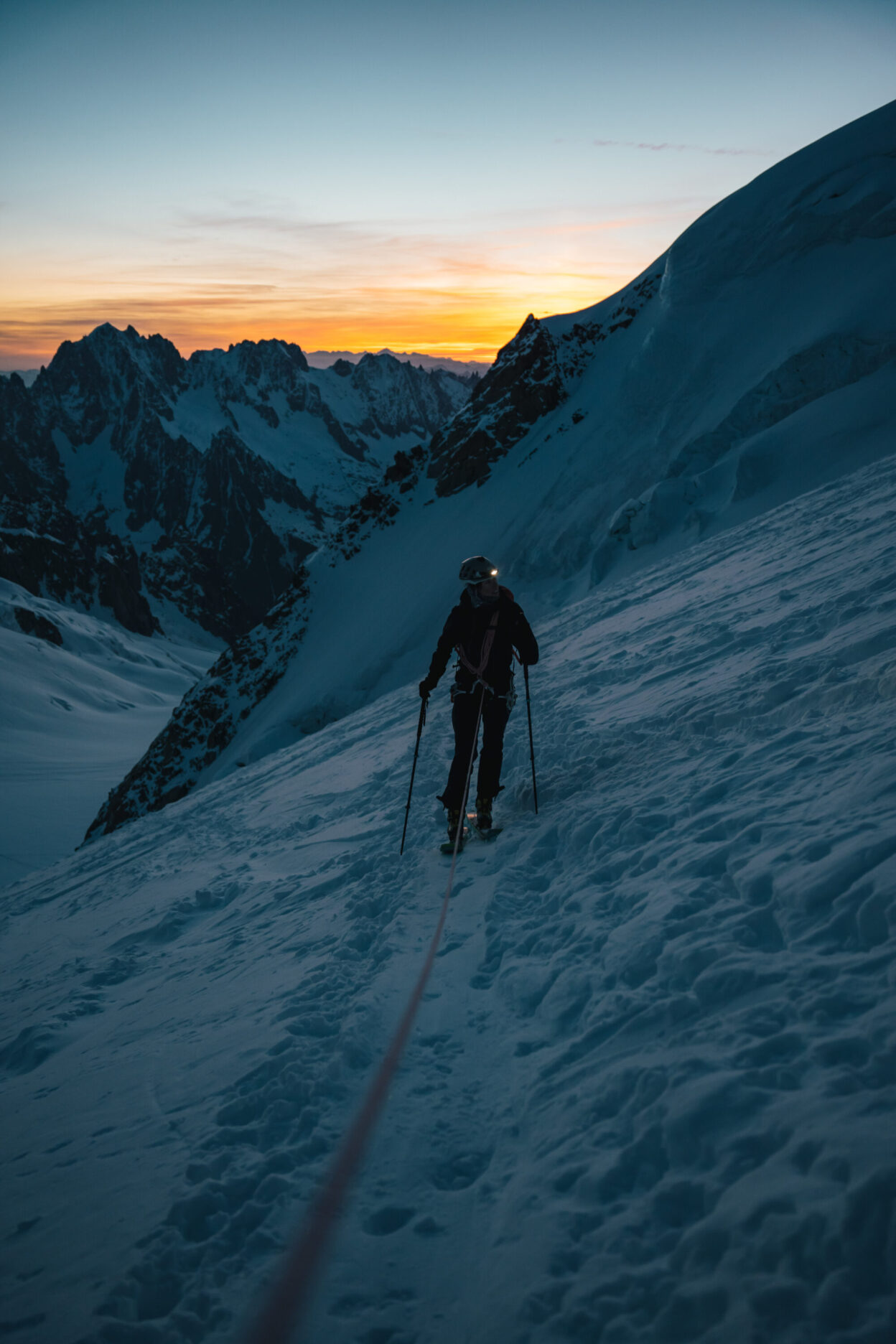
Jess and I skinning up in each others tracks at dawn. © Aaron Rolph
I look down at my leg, my ski still attached, dangling over a vast, airy chasm
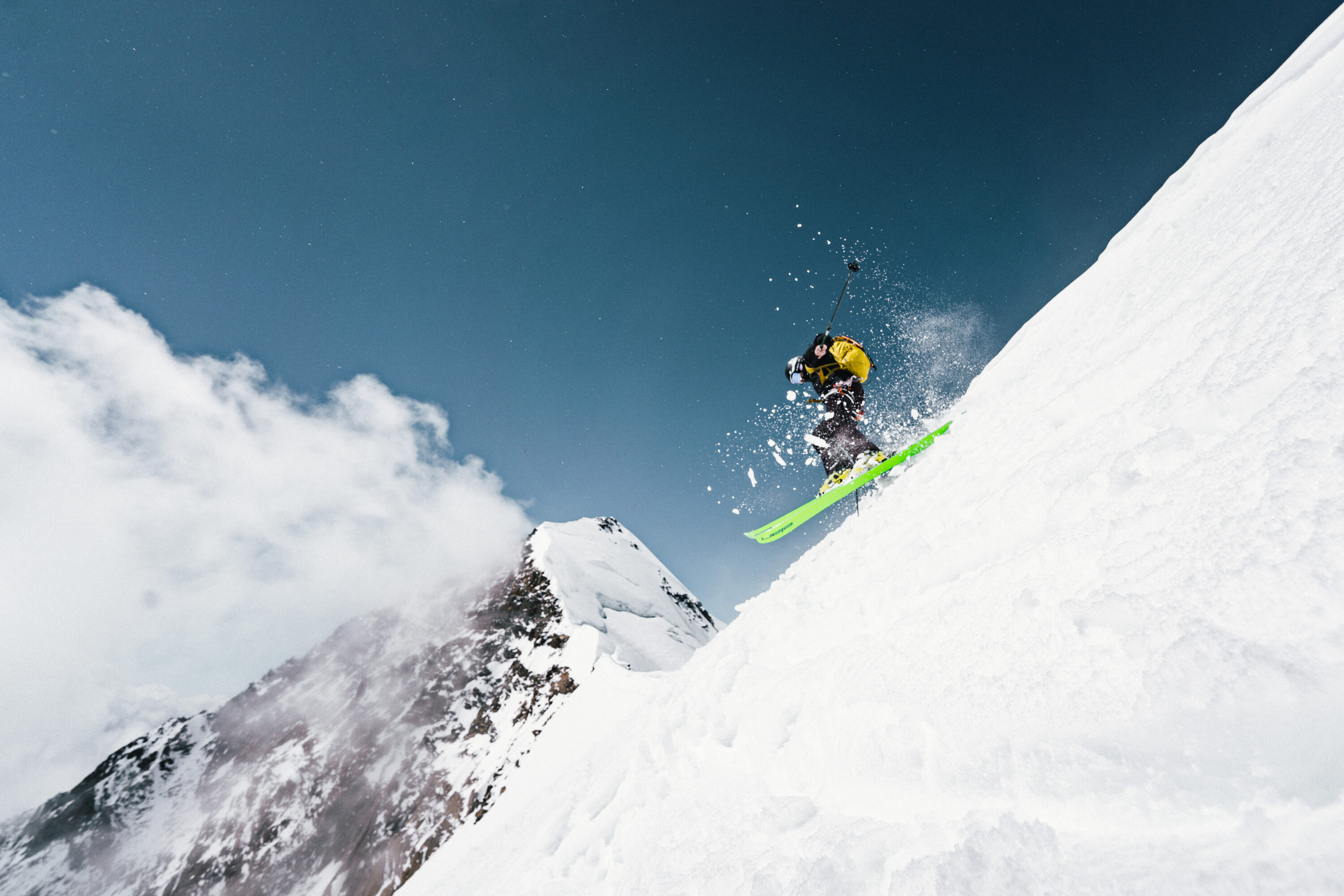
Dropping in off the Lyskamm ridge. © Aaron Rolph
Advised by the refuge guardian that no group has successfully crossed the large crevasses on the glacier route between the peaks this year, we opt for the ridge at the fork. Crossing the bergschrund proves tricky but not impossible, using both tools and our crampons to climb the icy wall. We can see plenty of fresh snow on the ridge, but as we start moving up the first pitches, it’s apparent there’s more to this. Our fears are confirmed as we realise the soft and light powder is just a covering for the very hard ice. Before long our calves are burning while we front point up the 50-degree slope. With plenty of ascent still to cover, we try to move fast and light, agreeing to not put in protection just yet, instead relying on the rope between us and our ability to self-arrest.
Nearing a steeper section of this exposed ridge, Jess loses a crampon footing and I find myself pulled abruptly tight on the rope from below. I sink my axes as deep as possible into the ice, holding both of our weight above a place you definitely wouldn’t want to fall. Jess calmly regains her footing and we agree to place ice screws from here on in. Covering this ground while putting in ice screws is slow going, but we are safer, at least. After the second band of ice, we move through the rocky arête covered by deep snow. Every step is a case of trial and error as we wait to see what will hold. Time marches on and what we hoped to be a simple enough route has thrown everything at us.
It soon turns 5pm and from here, with the summit only 50m above us, it feels like I could throw a stone to it. In current conditions however, this could easily take an hour or two and even then we’d be a long way from home, late in the day. With the weather expected to worsen and nightfall only a few hours away, we make the impossibly difficult decision – to turn around without the summit.
To be so close is salt in our wounds, but deep down I know this is the right call to make and I’m grateful to Jess for her measured influence. We’re forced to build a rappel down the worst of the ice and spend the next few hours retracing our steps, downclimbing into the darkness. The heavy snow has since returned but Jess and I hold our composure, battling down to where we know we can get our skis on and eventually, we carefully follow our skin track down through the nighttime blizzard.
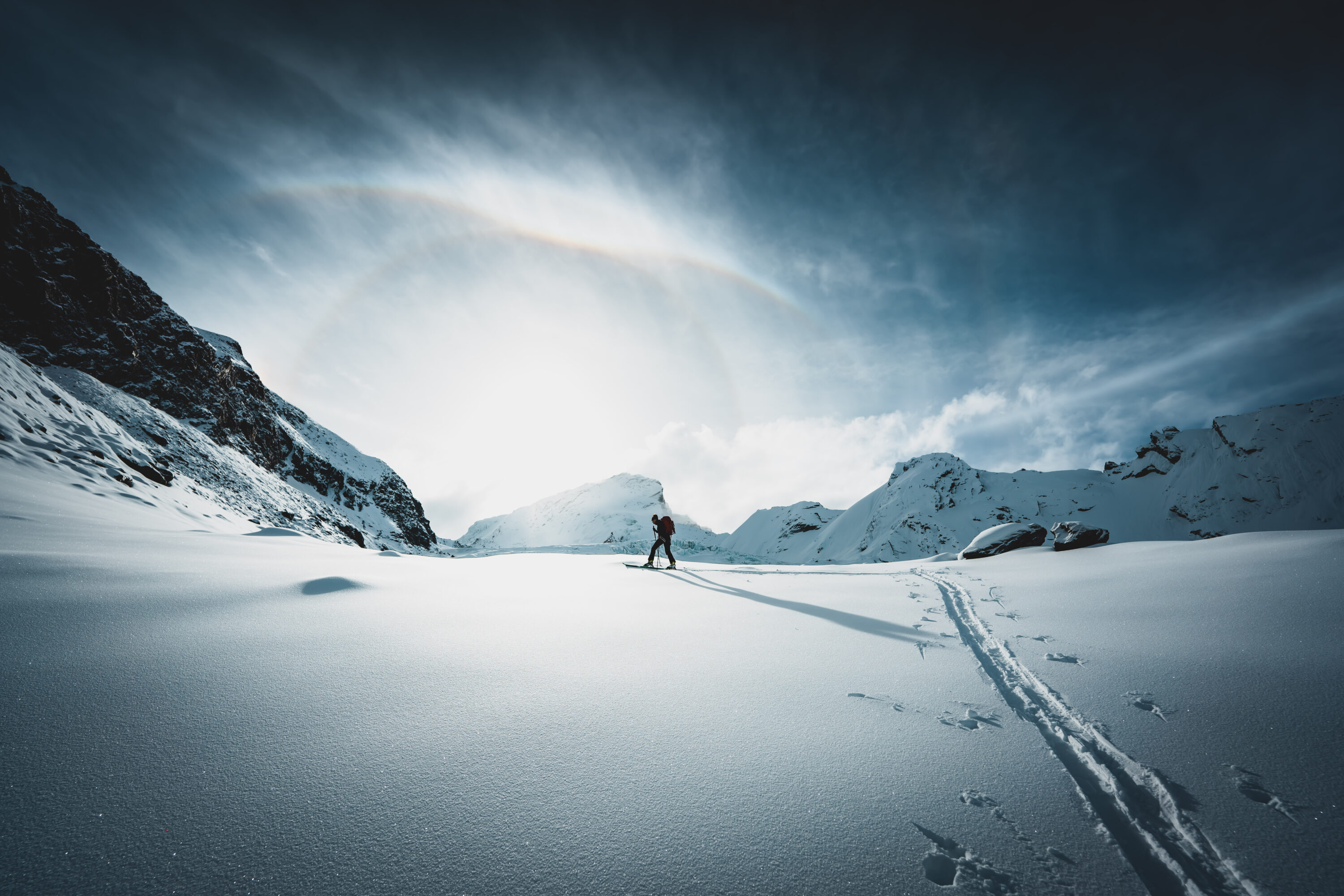
A small window of opportunity in what feels like perfect touring conditions on the Dom (4545m), the weather however soon rolled in and we were shut down once again. © Aaron Rolph
With the weather expected to worsen and nightfall only a few hours away, we make the impossibly difficult decision
After an 18-hour effort on the mountain, we return to safety and although I’m gutted not to have reached the top, the knowledge that we did all we could that day leaves us with some pride,and of course relief to be back down in one piece.
The following day, we return to Zermatt and even that is more of an ordeal than it would normally be. Faced with large glacial pools which can’t be navigated, not without a boat at least, we’re forced to climb to the next valley. With no time to spare, we avoid reflecting too hard and unpack and repack ready for our next objective, the Dom (4545m).
The access refuge is closed at this time of year, meaning after a short cycle, we find ourselves carrying supplies to the minimalist winter room. The 1500m scramble approach is involving and largely on foot. Despite the mellow forecast, we find ourselves climbing with loaded bags, skis and boots, enduring snow, rain and hail. Upon arrival, the winter room is extremely rudimental, with emergency bunk beds and blankets, but we make do. The persistent precipitation has left much of our clothing damp and without a source of heat, any attempts to dry our clothing prove largely futile.
Waking to an early alarm, we find the settled high pressure system we were expecting is nowhere to be seen and instead we’re greeted by yet another whiteout. After waiting an hour or so, the clouds lift enough for us to start touring and as the morning progresses, we’re treated to some spectacular pearly light with glistening snow. Once again we’re completely alone, breaking trail through a metre of deep, heavy snow. This is not the cruisy spring touring we’d signed up for. Despite a strong forecast, the clouds are once again building and before long we’re back in heavy snowfall.
At this point, we’re both getting a little bored of our bad luck. After a frank conversation, it becomes clear that the epic we had on Monte Rosa has knocked Jess more than we’d realised. In spite of this, she says she’s happy to continue through the bad weather, but we decide it’s not going to be our day and turn back just under 4000m.
Tired and frustrated, it appears the forecast looks much more favourable around Mont Blanc so we pack up the bikes and begin the 200km ride to Chamonix. We strap our skis and equipment onto our rigs making for a seriously heavy setup of around 40kg. It takes some getting used to but once we’re rolling, we’re both enjoying a change of scenery and the therapeutic process of spinning pedals.
As we get closer to our destination, we turn our attention to the long and relentless Col de la Forclaz (1527m) which with the weight on our bikes provides an impressive leg burn before the slightly less severe Col des Montets (1461m). Big smiles all round as we roll down to our home town of Chamonix, with it the sense of familiarity providing a noticeable increase in confidence. With no time to waste, we secured our refuge bookings at the Cosmiques, as the traditional ski route via Grand Mulet was fully booked (surely a good sign for our chances of success).
No rest for the wicked, we head straight up the following day, and although no one had been over the three Mont route yet this year we’re confident we can open it up. At the refuge, we meet a friendly local team also looking to get up Mont Blanc, meaning we’re able to share the hard graft. Another early start, and we’re enjoying a clear cut track up the Mont Blanc du Tacul (4248m) which we’re able to tour up almost entirely on our skis. Still feeling strong, we deviate to reach the Tacul summit itself before continuing onto Mont Maudit which is where the uncertainty will begin.
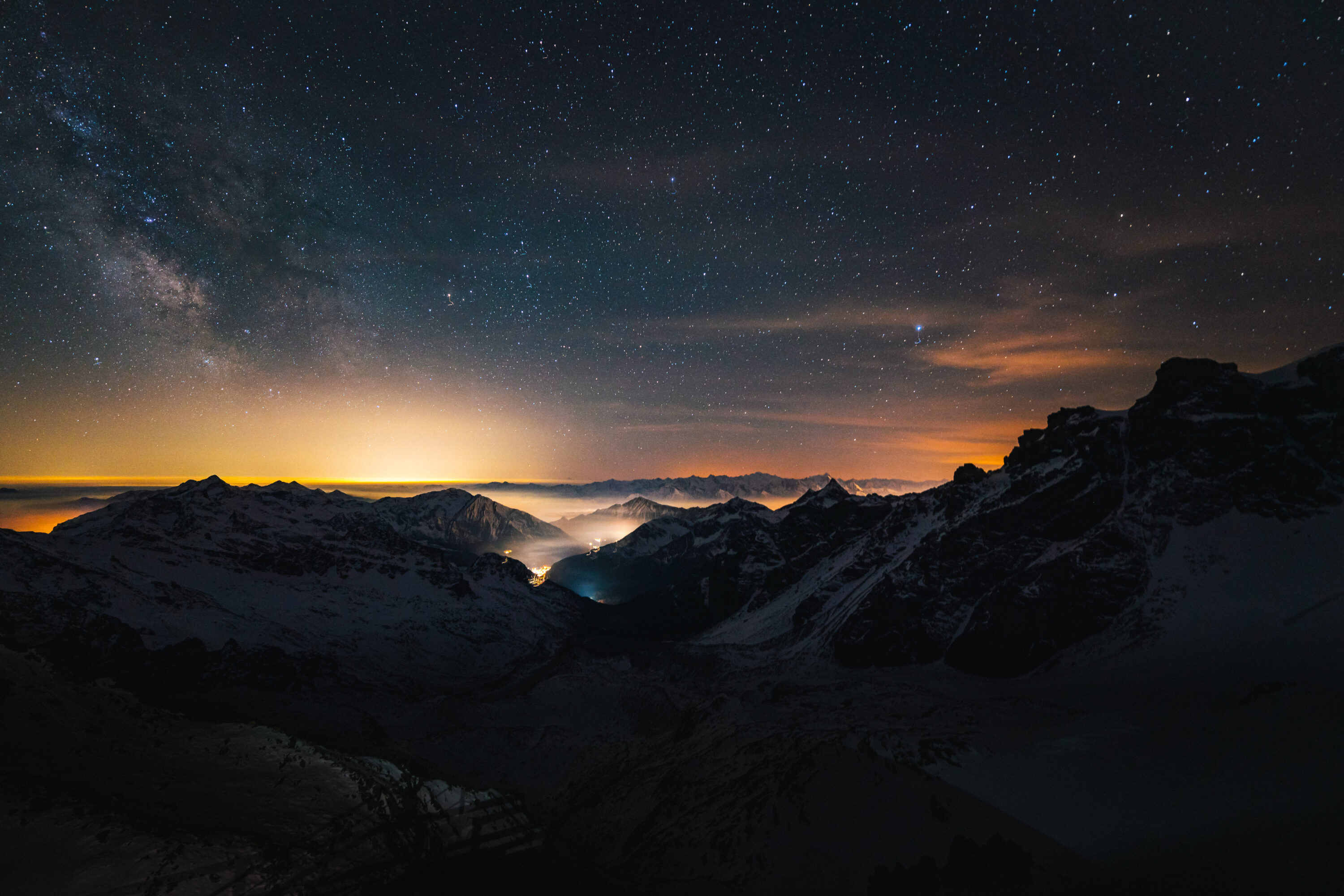
The sun sets over the Alpine X project. While not entirely successful, stringing together an ambitious challenge like this in their backyards and despite some extremely difficult conditions, returning home safely is always the biggest win, regardless of the number of summits ticked. © Aaron Rolph
We observe the French pair ahead with a watchful eye as they slowly navigate the crevasses, knowing our fate is likely to be similar to theirs. Mont Maudit doesn’t throw any major problems our way, other than a couple of short sections of ice and before long we’re over with our final peak in sight. Each time I climb the north face of Mont Blanc it’s a longer grind than I remember, however with so much acclimatisation under our belts this last couple of weeks, we feel strong all the way to 4810m. Jess and I take our final steps together, which of course feel significant after the never-ending hurdles on this trip. Putting in turns through deep powder on the highest peak in the Alps certainly provides some consolation for our big adventure.
But this journey is far from over. Admittedly, planning a back-to-back Alpine ski-mountaineering trip is inherently ambitious, but it was also a trip we learned so much on. We were required to constantly make serious decisions in the face of very challenging conditions and potentially life-threatening situations.
In the end we successfully climbed and skied a total of 12 x 4000m peaks including three of our Alpine 10, but our biggest achievement was probably coming back in one piece. For now, the adventure remains unfinished, and the anticipation of returning next year for round two, has already begun to build.
Don’t miss a single adventure
Sign up to our free newsletter and get a weekly BASE hit to your inbox
Other posts by this author
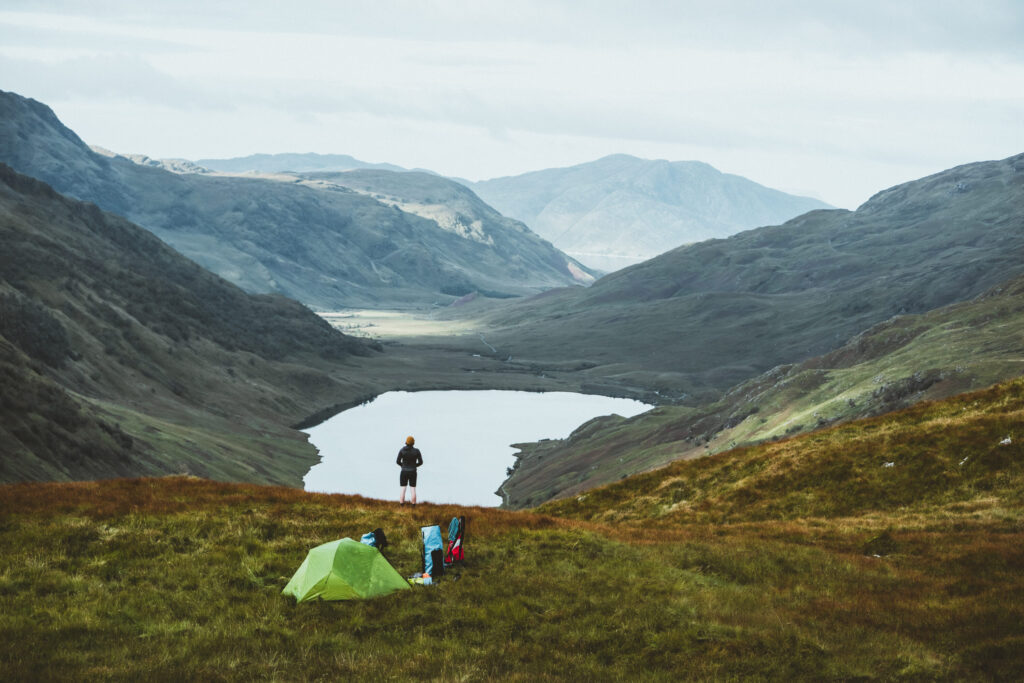
Story • Aaron Rolph • Nov 16, 2022
The UK’s Last Remaining Wilderness
A hike and SUP adventure to discover Knoydart, a wild peninsula in the Scottish Highlands

You might also like
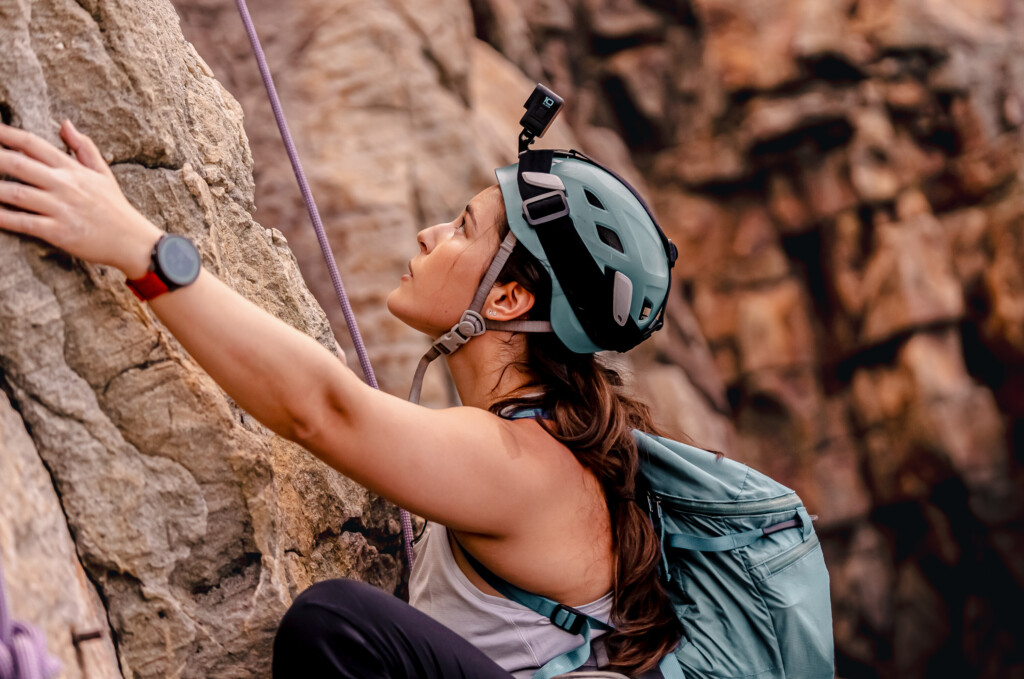
Photo Essay • BASE editorial team • Mar 18, 2024
Hunting happiness through adventure in Taiwan
BASE teams up with adventurer Sofia Jin to explore the best of Taiwan's underrated adventure scene.
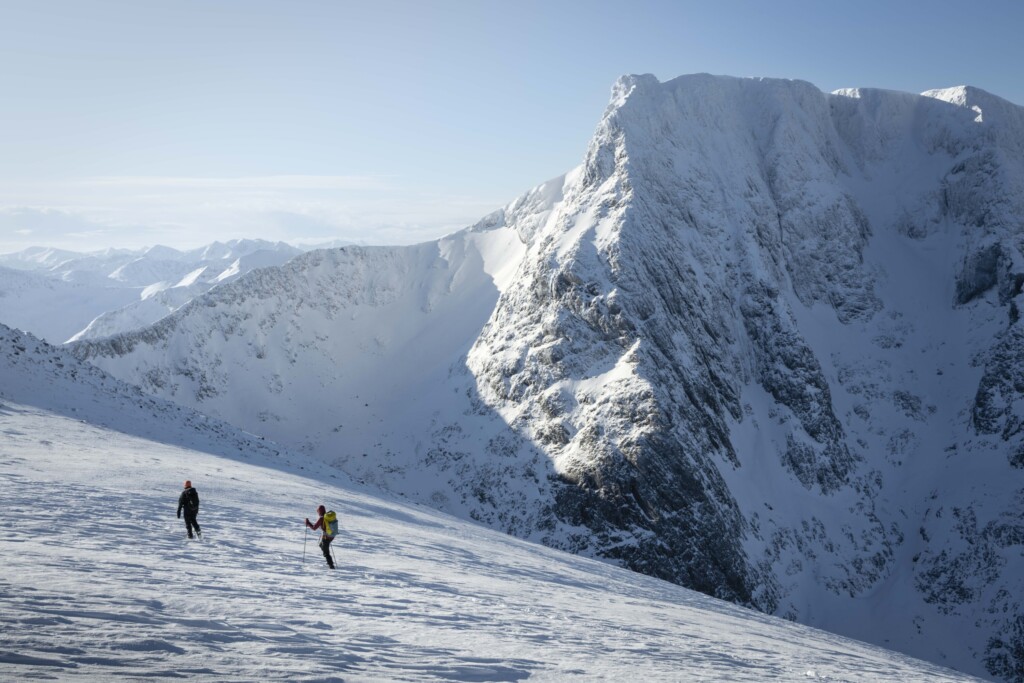
Story • BASE editorial team • Nov 21, 2023
Five Epic UK Climbs You Should Try This Winter
Craving a snowy mountain adventure? Inspired by the Garmin Instinct 2 watch (into which you can directly plan these routes), we've compiled a list of five of the best for winter 2023-24!

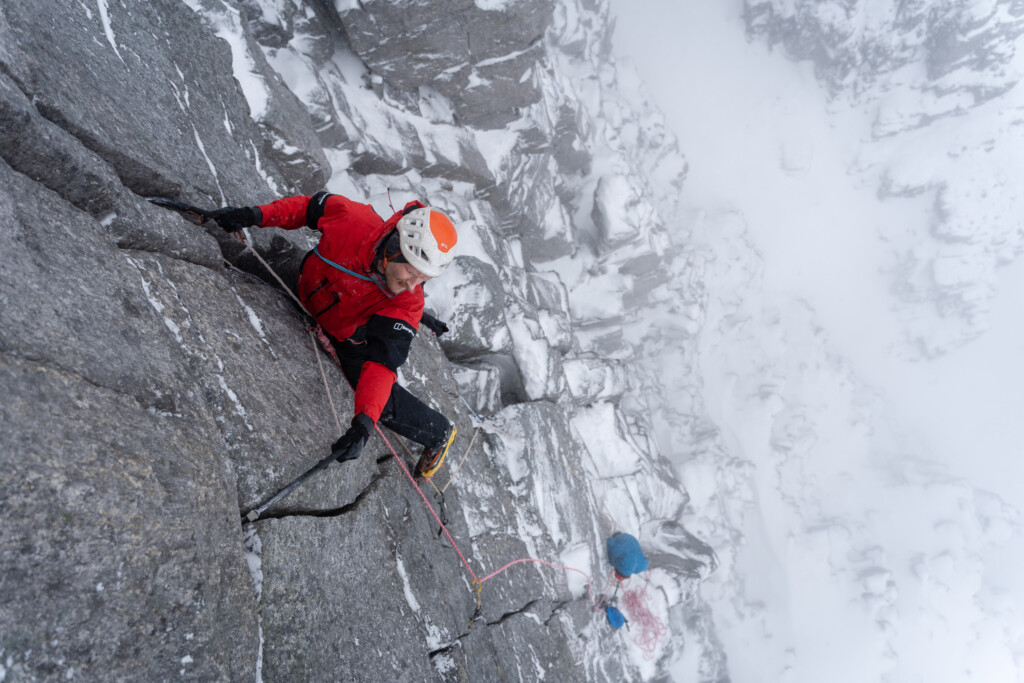
Video • BASE editorial team • Jul 21, 2023
Merging Two Lives: The Personal Journey of Hamish Frost
The challenges and triumphs of embracing sexuality in the outdoors

